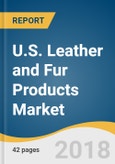The U.S. leather and fur products market size is estimated to rise to USD 19.77 billion by 2025., progressing at a CAGR of 5.3% during the forecast period. Proactive marketing initiatives by established brands in the country coupled with changing fashion trends are expected to boost market growth over the forecast period. Leather and fur are used for manufacturing a myriad of different products including women’s handbags, traveler bags, personal goods, and apparels, among others. Recent comeback of fur and leather products in popular fashion in urban areas has been a prime factor for steady rise in the demand. In addition, leather and fur product manufacturers have been focusing on providing enhanced shopping experiences and holding marketing campaigns, which is likely to further bolster the growth of the market. However, the market faces two major challenges in its long-term sustainability, which includes consumer and environmental backlash for the use of animal-derived products and internal competition from products made from artificial leather and faux fur. To address these challenges, major vendors in the market are focusing on partnerships with their contemporaries. Consumer purchasing preferences are anticipated to largely influence the dynamics of the market. The leather and fur products market in the U.S. is marked by presence of numerous well-known and established brands. While many of these players are large multinational companies, some vendors provide niche products, which has resulted in a highly fragmented marketplace.
Further key findings from the study suggest:
- Onset of online shopping portals has had a large impact on product marketing, sales, and delivery of leather and fur products. However, brick and mortar stores continue to be the most preferred distribution channel for the products
- The leather and fur products market includes a complex and globalized value chain wherein materials and finished products are often traded across national boundaries
- As of 2015, the types of leathers used worldwide included 34% of sheep, 30% of goat, 23% of cattle, and 13% of pig per animal hide. This, in terms of skin surface, translates to 59% cattle, 20% sheep, 24% goat, and 17% pig
- Introduction of numerous new products that are manufactured with leather and fur accessories such as eyeglass cases, jewelry cases, and personal electronics cases are expected to augment the personal goods market
- Samsonite International, LVMH Moet Hennessy Louis Vuitton, and Coach are some of the major vendors with a considerable influence on the market trends.
Table of Contents
Chapter 1 Methodology & Scope1.1 Research Methodology
1.2 Research Scope and Assumptions
1.3 List of Data Sources
Chapter 2 Executive Summary
2.1 U.S. Leather & Fur Products Market - Industry Snapshot & Key Buying Criteria, 2014 - 2025
2.1.1 U.S. leather & fur products market, 2014 - 2025
Chapter 3 U.S. Leather & Fur Products Industry Outlook
3.1 Market Segmentation
3.2 Market Size & Growth Prospects
3.3 U.S. Leather & Fur Products - Value Chain Analysis
3.4 U.S. Leather & Fur Products Market Dynamics
3.5 Market Size and Growth Prospects
3.5.1 Market driver analysis
3.5.1.1 Increase in spending capacity
3.5.1.2 Changing fashion trends
3.5.2 Market restraint analysis
3.5.2.1 Resistance from animal rights organizations
3.6 Penetration & Growth Prospect Mapping
3.7 U.S. Leather & Fur Products Market - Porter’s Five Forces Analysis
3.8 U.S. Leather & Fur Products Market - PESTEL Analysis
3.9 Key Company Analysis
Chapter 4 Competitive Landscape
4.1 Coach Inc.
4.1.1 Company overview
4.1.2 Financial performance
4.1.3 Product benchmarking
4.2.4 Strategic initiatives
4.2 LVMH Moet Hennessy Louis Vuitton S.E.
4.2.1 Company overview
4.2.2 Financial performance
4.2.3 Product benchmarking
4.2.4 Strategic initiatives
4.3 Kering
4.3.1 Company overview
4.3.2 Financial performance
4.3.3 Product benchmarking
4.2.4 Strategic initiatives
4.4 Samsonite International
4.4.1 Company overview
4.4.2 Financial performance
4.4.3 Product benchmarking
4.2.4 Strategic initiatives
4.5 VF Corporation
4.5.1 Company overview
4.5.2 Financial performance
4.5.3 Product benchmarking
4.5.4 Strategic initiatives
4.6 Rimowa
4.6.1 Company overview
4.6.2 Financial performance
4.6.3 Product benchmarking
4.6.4 Strategic initiatives
List of Tables
Table 1 Leather and fur products market - Industry snapshot & key buying criteria, 2014 – 2025
Table 2 U.S. leather and fur products market, 2014 - 2025 (USD Billion)
Table 3 U.S. leather and fur products market, by product, 2014 - 2025 (USD Billion)
Table 4 Leather and fur products - Key market driver impact
Table 5 Leather and fur products - Key market challenge impactList of Figures
FIG. 1 Market segmentation and scope
FIG. 2 Leather and fur products - Value chain analysis
FIG. 3 U.S. leather and fur products market, 2014 - 2025 (USD Million)
FIG. 4 Leather and fur products market dynamics
FIG. 5 Consumption growth trends for consumer durables
FIG. 6 Key opportunities prioritized
FIG. 7 Leather and fur products market - Porter’s five forces analysis
FIG. 8 Leather and fur products - PESTEL analysis
FIG. 9 Leather and fur products - Company ranking analysis
Companies Mentioned
- Coach Inc.
- LVMH Moet Hennessy Louis Vuitton S.E.
- Kering
- Samsonite International
- VF Corporation
- Rimowa
Methodology

LOADING...








